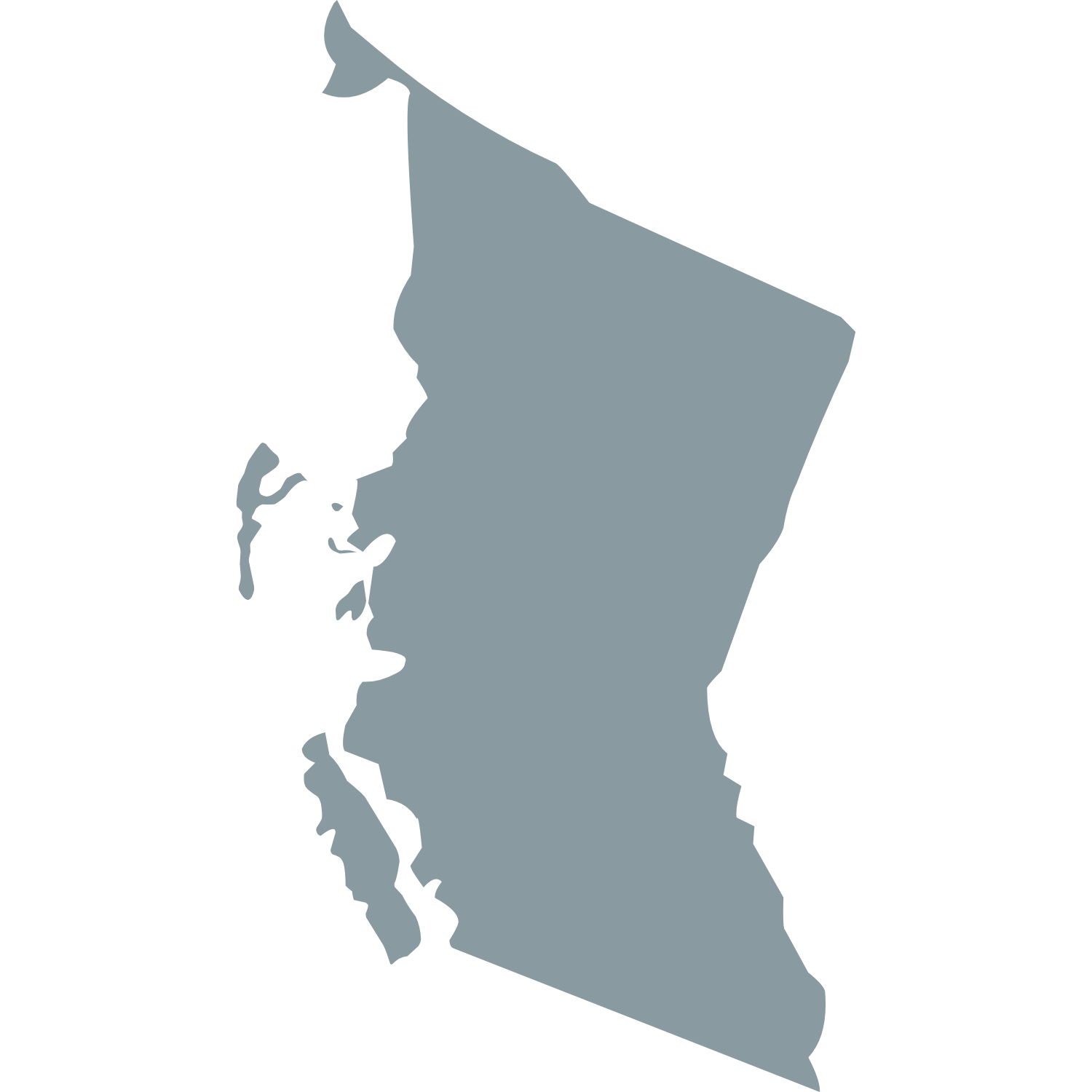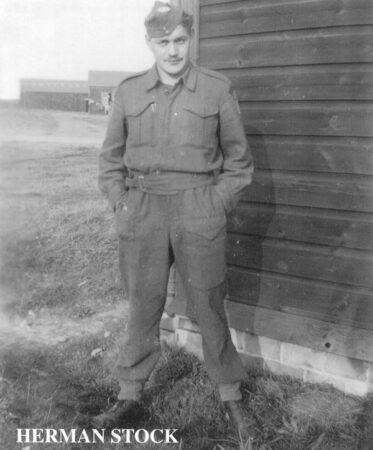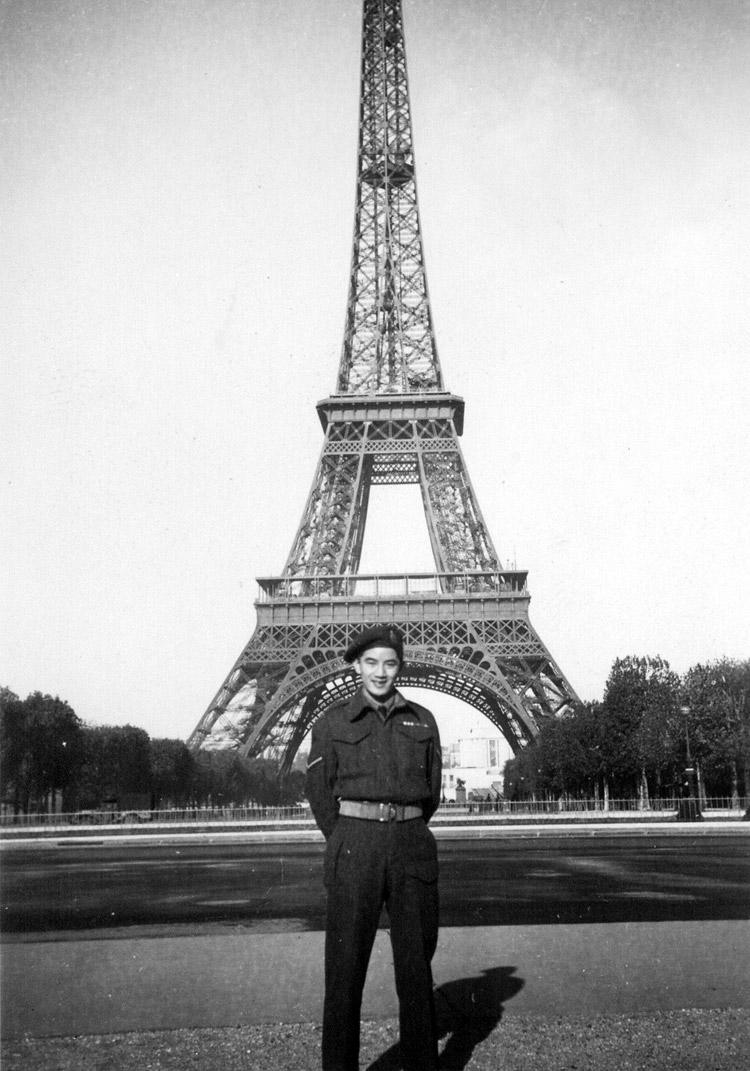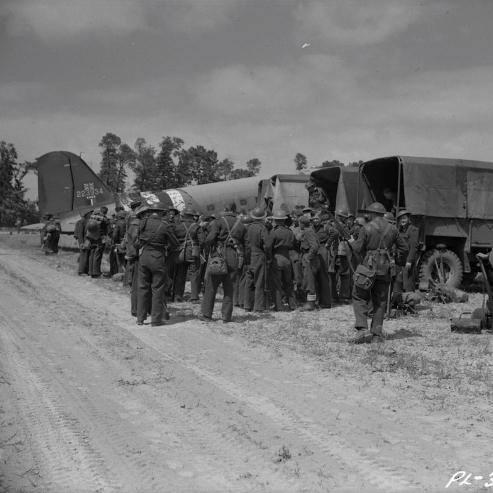THE HEROES OF NORMANDY
ONTARIO

Sheila Elizabeth Whitton
Born in Toronto on October 25, 1922 Sheila Elizabeth Whitton enlisted in the Women’s Royal Canadian Naval Service. She was stationed in Halifax and became a coder. In preparation for the D-Day invasion, she was sent to England in April 1944 where she worked on codes that helped to make the invasion successful. Shortly after arriving in England, she married her long-time boyfriend Robert Fleming, who was serving overseas with the Queen’s Own Rifles. Sadly Robert died shortly after D-Day on June 11th, leaving Sheila a widow.
Alex Polowin
Able Seaman (Ret’d) Alex Polowin was born in Lithuania and immigrated to Canada as a young child. He enlisted in the Navy in 1941 after hearing accounts from his family back in Lithuania about the Nazi’s treatment of Jews. During the Normandy Invasion, he and the other crew members aboard the HMSC Huron ensured that enemy ships could not attack Canadian landing craft. After the war, he returned to his home in Ottawa and lived there until his death in 2022.
Herman Stock
Herman Stock was born in Sahanation on Wahta Mohawk Territory in 1922. He enlisted in 1941 and was at Juno Beach with A Company of the Queen’s Own Rifles. Unfortunately, A Company endured heavy machine fire as they arrived on the beach. Within moments of arriving at the beach, Stock was killed. He is buried At Beny-Sur-Mer Canadian War Cemetery.
Clarence David Lapierre
Clarence David ‘Dude’ Lapierre was born in Owen Sound in 1923. He enlisted in 1943 and transferred to the 1st Canadian parachute battalion in 1944. Early on June 6th, Lapierre parachuted into an area East of Caen with the goal of destroying bridges used by the Germans to get supplies and reinforcements. Sadly, Lapierre was wounded and died on June 7th 1944. He is buried in Ranville War Cemetery in France.
Dorothy Irene Mulholland
After working as a nurse in Brampton, Ontario, Dorothy Irene Mulholland volunteered for the Royal Canadian Air Force. Dorothy worked hard from the moment she enlisted, becoming the nurse in charge of her section’s operating room. In 1944, she was one of the first three nurses sent to Normandy to support the troops during the invasion. Conditions there were extremely difficult, as she described operations lasting up to 72 hours in the middle of bombardments! Dorothy remained in France for eight months before returning home with honor.
Canadian nurses of the Royal Canadian Army Medical Corps (R.C.A.M.C.) assemble bandages in a British hospital in Normandy, July 17, 1944.
Jack Henry Hilton
Born in Scarborough in 1919, Jack Henry Hilton was a flight instructor in the air force before being posted overseas as a pilot. During D-Day, he was tasked with providing close air support for the landing crafts. Through poor weather conditions, he flew his Hawker Typhoon and defended the troops crossing Juno Beach from German convoys and guns. He passed away in Airdrie, Alberta at the age of 99 in 2019.
Lester Brown
Lester ‘Bub’ Brown was drafted into the Canadian Army when he was 23 and took part in the Normandy Invasion with the Queen’s Own Rifles. Although he made it past the beach without injury, he was wounded in both the knee and chin while helping to take the town of Bretteville-sur-laize. After the war, he worked as a railway porter and conductor for the Canadian Pacific Railway. At the time of his death in 2013, he was considered the last Black Canadian to take part in the D-Day invasions.
John Arthur Alexander
The son of African-Canadian and Indigenous parents, John Arthur Alexander was born on the Six Nations Reserve in 1918. After marrying his partner Jean Alexander in 1942, John joined the Queen’s Own Rifles and left for Europe. His role in Normandy was to blow up part of the German defenses, and although he succeeded in his mission, his unit suffered heavy casualties. John himself was wounded several times during the fighting in France, Holland and Germany, but survived the war and returned home safe.
Lloyd Turner
Enlisting with the Queen’s Own Rifles, Lloyd Turner quickly rose through the ranks to become sergeant. At Juno Beach, he commanded part of the regiment’s troops and faced German machine-gun fire. His account of the Normandy landings is striking, as he describes in detail the conditions on the beach and the damage caused by enemy defenses. After fighting almost everywhere in Europe, he was wounded three times in all, and learned of the end of the war in a Belgian hospital. Until his death in 2002, Lloyd was married to his wife Rose Anne Pether and had two children.
QUEBEC

Emilien Dufresne
Born in Gaspésie in 1923, Private Emilien Dufresne was one of many Canadians taken prisoner by the Wehrmacht during the war. After landing in Normandy with the rest of the Régiment de la Chaudière, he was captured during the night and transported across France in animal convoys, ending up in a German prison camp. It was only on April 9, 1945, when the American army arrived at the camp, that Emilien was released from captivity and able to return home. Years later, he published his memoirs Calepin d’espoir.
Léo Major
From Europe to Korea, Private Léo Major’s military exploits might be so impressive that they seem false. Léo enlisted in the army in 1940 and quickly joined the Régiment de la Chaudière, which became his home unit for the duration of the war. From the time he landed in Normandy on June 6, 1944, until the end of the war, Private Major performed one feat after another: seizing vehicles, capturing enemy soldiers and, finally, liberating an entire city. For the rest of his life, he was regarded as a great hero in Zwolle and in Canada.
Lorenzo Tremblay
A native of Val-Brillant in the Bas-Saint-Laurent region, Lorenzo Tremblay joined the army on July 10, 1941, with the Fusiliers du St-Laurent. In Europe, he was transferred to the Régiment de la Chaudière and landed with them in Normandy. Promoted to sergeant, Lorenzo fought in France, the Netherlands and Germany until the end of the war. He died in 2023, aged 101.
John Hanson, M.C.
Of British origin, John Hanson grew up in Montreal, where he learned French before enlisting in the Canadian infantry. During the war, he volunteered to become a paratrooper and trained with the 1st Parachute Battalion until the Normandy landings. His parachute landing there was his first field operation and his mission was to neutralize the German garrison at Varaville to facilitate the arrival of troops on the beaches. During the operation, his superior officer was quickly shot down, and Hanson immediately took it upon himself to mobilize his comrades and bring the mission to a successful conclusion. Hanson continued to fight in Europe until March 1945, when he was wounded twice.
BRITISH-COLUMBIA

Frank Bing Wong
Frank Bing Wong was born in Vancouver in 1919 but grew up in the small fishing village of Alert Bay, British Columbia. He enlisted in 1942, saying that he saw joining the army as an opportunity to show his loyalty to Canada, and hoping that he would gain the right to vote after the war, as he, like most Chinese Canadians at the time, did not have full rights in Canada. His service in an artillery repair unit brought him to Barrie, Ontario, Scotland, and finally to Juno Beach.
Frank landed on Juno Beach about a month after D-Day, and participated in the liberation of Caen, where he said he felt ill from the sight and smell of so many corpses. He went on to participate in the liberation of the Netherlands as well. After the war, Chinese Canadian veterans fought for their rights and, in 1947, the Canadian government repealed the ban on Chinese immigration and gave Chinese Canadian citizens full enfranchisement.
MANITOBA

Bertha Annie “Bertie” Hull
Bertha Annie “Bertie” Hull was born in 1917 in Winnipeg and served as a nurse during WWII. She enlisted in Halifax and was sent to England to join a team of 50 nurses who were responsible for a 500-bed hospital. She was in England during the Blitz, as German bomber planes flew over the hospital where she was working. When D-Day came, Bertie and her team were ready. She later recounted that D-Day was a sad time because the injured soldiers and officers that were returning from France were men she knew and may have danced with. Bertie continued her career as a nurse after the war, working at Sechelt Hospital in British Columbia for 35 years.
NOVA-SCOTIA

Everett Sylvester Cromwell
Everett Sylvester Cromwell was born in Weymouth Falls, Nova Scotia in 1921. When WWII started in 1939, he saw the Army turning Black people away, but by the time he enrolled in 1941, he had no problems. He was put into the Royal Canadian Army Service Corp and was told he’d probably be driving vehicles, to which he replied, “I had never been inside a vehicle for a drive let alone drive one.”
After intensive training in England, however, Cromwell became an integral part of a munitions transport unit that landed on Juno Beach with 30 trucks. He and his team would load supplies off ships and drive them to the front lines, where they were in firing range of the Germans. On the return voyage, they would bring German prisoners of war back to the ships. After the war, Cromwell remained in the Canadian Armed Forces until retirement in 1971. He was also a founding member of the Black Loyalist Heritage Society in Nova Scotia.
Courtesy of Historica Canada.
“Anybody that say they wasn’t scared, they’re not telling you the truth because if you’re not scared, you’ll get killed.”
– Everett Cromwell, member of the Royal Canadian Army Service Corps, Veterans Affairs Canada
SASKATCHEWAN

James Stocky Edwards
James Francis “Stocky” Edwards was born in Nokomis, Saskatchewan in 1921. He enlisted in the Royal Canadian Air Force in 1940 and, after completing his training in England, became one of the rare Allied pilots to fight in all of the major Allied campaigns: the North African, Italian and North-West Europe campaigns. His record includes shooting down 19 enemy aircraft (plus 7 more “probables”) and destroying 12 aircraft and 200 vehicles on the ground. He was considered a flying ace and one of the Commonwealth’s top fighter pilots. Promoted to squadron leader after his actions in Italy, he and his team flew in support of the Normandy landings on June 6, 1944. Edwards remained in the RCAF until his retirement in 1972.
Philip Favel
Philip Favel was born in 1922 on the Sweetgrass First Nations reserve in Saskatchewan. In 1942, at the age of 20, he left his father’s farm to join the Army and was enrolled in the Royal Canadian Army Service Corps where he became a driver for the 8th Canadian Infantry Brigade. After landing on Juno Beach, Favel was responsible for driving precious supplies, such as ammunition and gas to the front lines. On multiple occasions, Favel’s truck came under direct fire, destroying his windshield and damaging the vehicle, but he never faltered. He did stop, however, to help an injured person and take care of two children, actions that earned him the French Legion of Honour medal. Returning from Europe in 1945, Favel saw that veterans were eligible for numerous benefits such as financial compensation, vocational training, and assistance with land and home purchases. Most Indigenous veterans, however, were denied access to those benefits. Favel spent years fighting this injustice and advocating for fair compensation for Indigenous veterans.































